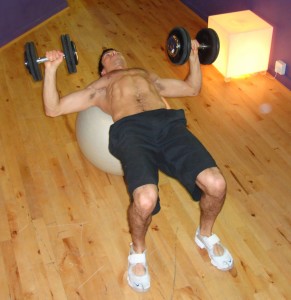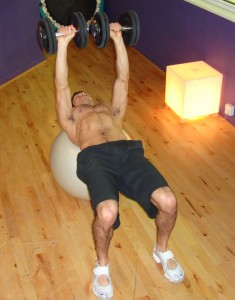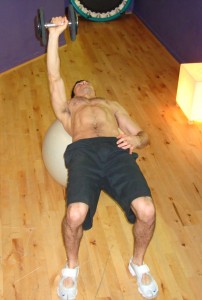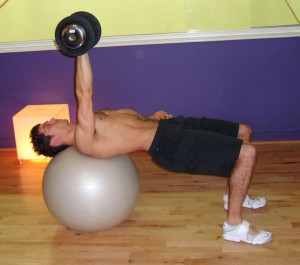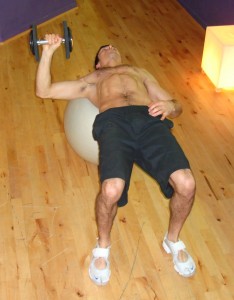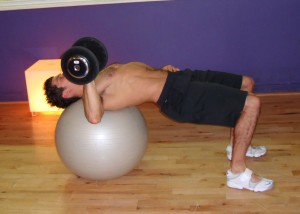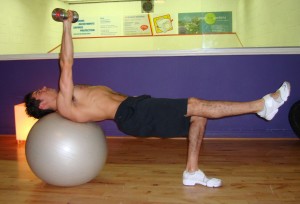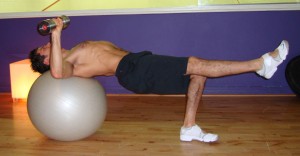DB Chest Press
DB Chest Press on Swiss Ball
This exercise targets the pectoralis major, minor (chest) and tricep (back of the arm) muscles. As the exercise is performed using a swiss ball it also uses the core muscles and gluteals. This is because the ball offers an unstable environment and causes the core muscles to work extremely hard. The gluteals are also given a workout as they are used to keep the hips up throughout the exercise.
How To
Sit on a swiss ball holding 2 dumbbells on your lap. Slowly roll down the ball and bring the dumbbells to the side, parallel with your chest and with your head and shoulders supported (pictured below). Your feet should be hip-width apart with the toes pointing forward.
Activate your TVA by gently drawing your navel toward your spine. Exhale and push the dumbbells up above your sternum (chest bone-pictured below). Inhale as you bring the weights back down to the start position and repeat. Keep your hips up so they are level with your shoulders and knees throughout the set. Once you have finished the set bring the dumbbells down to your chest and slowly sit up again.
Start by performing 2 sets of 12-15 repetitions. Focus on keeping your balance and hips still as you perform the exercise.
Important Note: If you feel dizzy at any point during the exercise STOP IMMEDIATELY.
Single Arm Dumbbell Chest Press on Swiss Ball
This is a more advanced version of the exercise as it poses a much bigger balance challenge. Holding the DB in one hand shifts the centre of gravity over to that side, this causes the core muscles and gluteals to work even harder as they try to keep the hips level.
How To
Sit on a swiss ball with a dumbbell in one hand, resting on your lap. Slowly roll down the ball until you are lying on your back with your head and shoulders supported by the ball, your feet should be hip-width apart. Start with the dumbbell directly above your sternum (pictured below). The reason for starting in this position is it maintains a normal centre of gravity and allows you to get in the correct position.
Activate your TVA by gently drawing your navel toward your spine and slowly lower the dumbbell out to the side until your elbow is level with your shoulder (pictured below). Exhale as you push the dumbbell up above your sternum and repeat. Keep your hips level thoughout the movement, it can help to use the hand that is free to check if it is twisting. Once you have finished the set bring the dumbbell to your chest and sit up slowly on the ball again.
Start by performing 2-3 sets of 10-12 repetitions on each side with a 2-1-2 tempo (this means it takes 2 seconds to lower the dumbbell, a 1 second pause and then 2 seconds to return to the start position).
Important Note: If you feel dizzy at any point during the exercise STOP IMMEDIATELY.
Single Arm / Single Leg Dumbbell Chest Press on Swiss Ball
This is an extremely difficult exercise that requires a high degree of balance and co-ordination. By lifting one leg there are only 2 points of contact with the floor; the remaining leg and the swiss ball (which itself is an unstable surface!). The core muscles and gluteals have to work extremely hard to maintain balance and alignment throughout the exercise.
How To
Sit on swiss ball and hold a dumbbell in one hand. Slowly roll down the ball until your head and shoulders are supported, lift the dumbbell up directly above your sternum. Avtivate your TVA by gently drawing your navel toward your spine. Keeping your hips level, slowly raise the foot on the same side as the dumbbell and extend it so that it is level with your hips and shoulders (pictured below).
Slowly lower the dumbbell until your elbow is level with your shoulder (pictured below). Keep your hips up level with your shoulders and do not let your hips twist. Exhale as you press the dumbbell back to the start position and repeat.
Start by performing 8-10 repetitions on one side then repeat on the opposite side. As you become more accustomed to the exercise build up to 10-12 reps per side. Increase the challenge by increasing the speed at which you perform the movement.
Important Note: If you feel dizzy at any point during the exercise STOP IMMEDIATELY.

